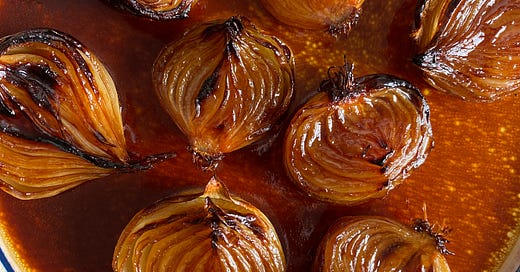I live a hop, a skip and a jump away from the Pophams marmite, Scholssberger and spring onion pastry and this is a geographical blessing for which I am very grateful. As with any spiralled pastry, I always devour them the same way: from the outside in, one torn piece at a time, flakes of pastry and countless sesame seeds collecting in my lap, working my way towards the innermost wheel where the spring onion is the most tender and the pastry has seemingly soaked up the most marmite. It’s the perfect last bite, one that I’ll hop, skip and jump to, even on the sleepiest of Sunday mornings for many more years to come.
I wax lyrical about that pastry here as a thank you to Pophams for inspiring today’s combination of marmite and onions. And another thank you must go to the cookbook Flavour (by Ottolenghi and Ixta Belfrage if you didn’t already know, although I’m sure you did) for inspiring the method.
Various routes you could take these marmite butter onions down:
~ Spoon onto toast and shower with mature cheddar
~ Roughly chop and simmer with good quality chicken stock for a very untraditional take on French onion soup. Floating cheesy toasts if you’d like to go the distance (and let me tell you, you’d like to go the distance)
~ Serve alongside a roast chicken
~ Roughly chop and toss through pasta (with a good slosh of pasta water of course) to channel Queen Nigella’s infamous marmite pasta
~ Use a few spoonfuls of the marmite butter liquid to briefly braise dark leafy greens then stir through the onions just before serving
~ I have gone on record stating that mash is my least favourite way with potatoes but if you’re a fan, pile the onions onto a puffy cloud of mash
~ As a superior alternative to mashed potatoes (in my opinion), smash butterbeans in frothing, garlicky butter then add in plenty of chives and a big handful of grated cheddar. Crown with the onions.
Marmite butter onions
Look out for small onions, preferably smaller than a tennis ball. In the UK, I find the bags or larger nets of onions sold in supermarkets often contain smaller ones than those sold loose or in smaller nets of three. If you can’t find small onions, you could use larger shallots as an alternative or just use the smallest onions you can find and increase the cook time (both the covered and uncovered timings, adding a splash more water towards the end, if needed) to ensure they are completely tender.





